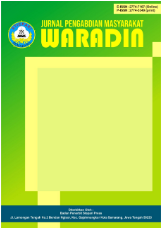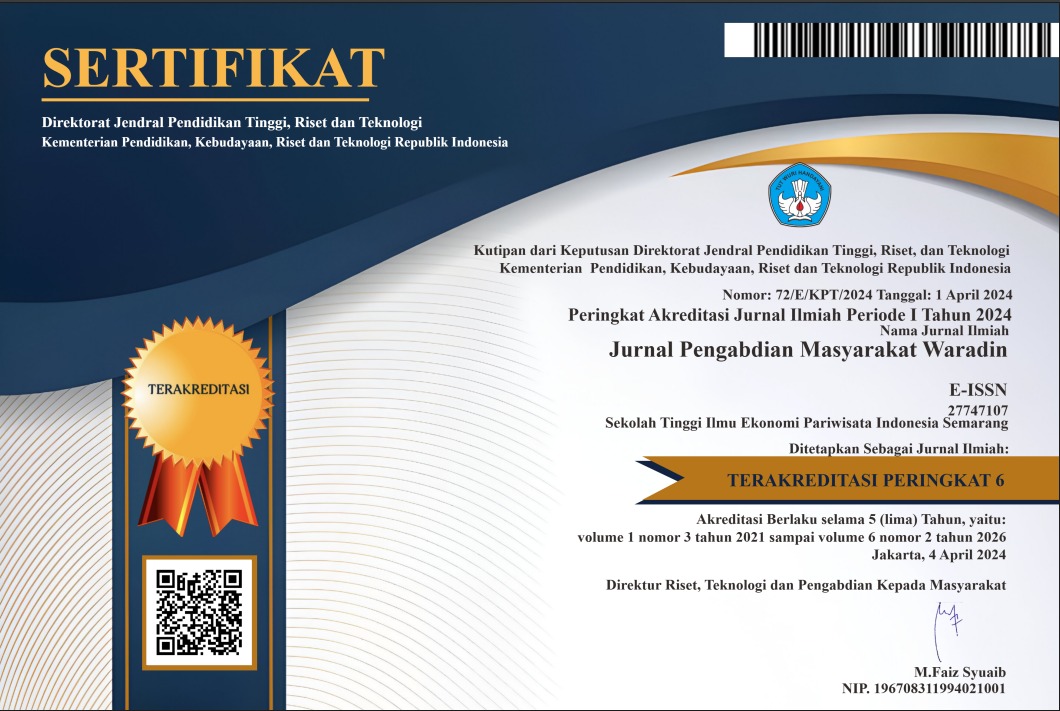Edukasi Pentingnya Pemberian ASI Eksklusif pada Masyarakat Desa Allang Asaude
DOI:
https://doi.org/10.56910/wrd.v5i2.621Keywords:
Exclusive Breastfeeding, Education, KnowledgeAbstract
The First 1000 Days of Life (HPK) period is a crucial time that greatly influences a child's physical and cognitive development. During this period, fulfilling nutritional needs, especially through exclusive breastfeeding and appropriate complementary feeding, is very important. This community service activity aims to improve mothers' understanding of the importance of exclusive breastfeeding for mothers and babies. This community service activity was carried out by providing education to 12 breastfeeding mothers at the Sinar Kasih Integrated Health Post, Allang Asaude Village, Waesala Health Center area, Huamual District, West Seram Regency, through the distribution of leaflets and interactive question and answer sessions. The results showed that this activity succeeded in improving the understanding of the counseling participants about the benefits of exclusive breastfeeding for babies and mothers. This education is expected to encourage better exclusive breastfeeding practices, which will have a positive impact on children's health in the future.
References
Eidelman, A. I., & Schanler, R. J. (2012). Breastfeeding and the use of human milk. In Pediatrics, 129(3). https://doi.org/https://doi.org/10.1542/peds.2011-3552
F.A Wijaya. (2019). ASI Eksklusif: Nutrisi Ideal untuk Bayi 0-6 Bulan. Cermin Dunia Kedokteran, 46(4), 296–300. https://doi.org/https://doi.org/10.55175/cdk.v46i4.485
Fera The, Marhaeni Hasan, S. D. S. (2023). Edukasi Pentingnya Pemberian ASI Eksklusif pada Bayi di Puskesmas Gambesi. Jurnal Surya Masyarakat, 5(2). https://doi.org/https://doi.org/10.26714/jsm.5.2.2023.208-213
Gunardi, H. (2021). Optimalisasi 1000 hari pertama kehidupan: nutrisi, kasih sayang, stimulasi, dan imunisasi merupakan langkah awal mewujudkan generasi penerus yang unggul. E-Journal Kedokteran Indonesia, 9(1). https://doi.org/https://doi.org/10.23886/ejki.9.2
Hukubun, R. D., Paulus, J. M., Nustelu, J., Ayuasthika, V., Kufla, Y. J., Huwae, L. M. C., & Huwae, L. B. S. (2024). Sosialisasi Perilaku Hidup Bersih Dan Sehat di Sekolah Dasar Negeri Naku. ALKHIDMAH: Jurnal Pengabdian dan Kemitraan Masyarakat, 2(1), 08-17.
Hukubun, R. D., Huwae, L. M. C., Huwae, L. B. S., & Huka, J. A. F. (2024). SEHATI: Sosialisasi Pencegahan dan Aksi Penanganan Stunting di Negeri Hatalai, Kota Ambon. Sejahtera: Jurnal Inspirasi Mengabdi Untuk Negeri, 3(1), 17-28.
Huwae, L. M. C., Dabutar, P. S., Oeijano, G. A., Kundiman, C. R., Mahua, A. U., & Hukubun, R. D. (2023). Pelaksanaan Skrining Kesehatan sebagai Upaya Mencegah Penyakit Tidak Menular pada Usia Produktif dan Lansia di Negeri Latuhalat. Sejahtera: Jurnal Inspirasi Mengabdi Untuk Negeri, 2(1), 26-36.
Kementerian Kesehatan Republik Indonesia. (2021). Profil kesehatan Indonesia tahun 2020.
Lawalata, F. F., Cornelis, M., Hutubessy, V. I., Tuapattinaya, B. T. V., & Hukubun, R. D. (2022). Mitigasi Bencana Tsunami Bagi Siswa SD Negeri 1 Latuhalat. ABDIKAN: Jurnal Pengabdian Masyarakat Bidang Sains Dan Teknologi, 1(2), 201-206.
Sari, W. A., & Farida, S. N. (2020). Hubungan Pengetahuan Ibu Menyusui tentang Manfaat ASI dengan Pemberian ASI Eksklusif Kabupaten Jombang. Jurnal Penelitian Kesehatan, 10(1), 6–12.
Umboh, E., Wilar, Rocky, & Mantik, M. F. J. (2013). Pengetahuan Ibu Mengenai Manfaat ASI pada Bayi. Jurnal E-Biomedik (EBM), 1(1), 210–214.
Waluyo D, Rahim E, Mutiatu St. R, & C. Y. M. (2022). Hubungan Pengetahuan Ibu dan Pemberian Asi Eksklusif dengan Status Gizi Anak Usia 6-24 Bulan di Kelurahan Moodu Kecamatan Kota Timur Kota Gorontalo. Graha Medika Public Health Journal, 1(2), 91–99. https://journal.iktgm.ac.id/index.php/publichealth/article/view/104
WHO. (2003). Global strategy for infant and young child feeding.
Yuliawati Y, Sadiman S, Widiyanti S, A. L. (2022). Faktor-faktor yang berhubungan dengan ketidakstabilan ASI Eksklusif pada ibu menyusui di Puskesmas Yosomulyo Kota Metro. JOEL: Journal of Educational and Language Research, 2(4), 563–574. https://doi.org/https://doi.org/10.53625/joel.v2i4.4112







